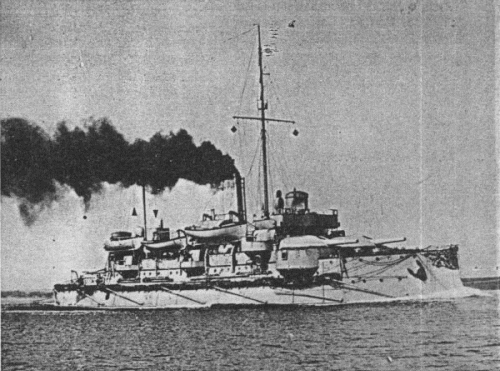

Siegfried 1890

Hagen 1910
| Name | No | Yard No | Builder | Laid down | Launched | Comp | Fate |
| Siegfried | 44 | Germaniawerft, Kiel | 1888 | 10.8.1889 | 29.4.1890 | barrack ship 1916 | |
| Beowulf | 100 | Weser, Bremen | 1890 | 8.11.1890 | 1.4.1892 | target ship 1916 | |
| Frithjof | 101 | Weser, Bremen | 1890 | 21.7.1891 | 23.2.1893 | barrack ship 1916 | |
| Heimdall | 14 | Wilhelmshaven KW | 1891 | 27.7.1892 | 7.4.1894 | barrack ship 1916 | |
| Hildebrand | 20 | Kiel KW | 1890 | 6.8.1892 | 28.10.1893 | barrack ship 1916 | |
| Hagen | 21 | Kiel KW | 1891 | 21.10.1893 | 2.10.1894 | barrack ship 1916 |
|
Displacement normal, t |
3691 |
|
Displacement full, t |
3741 |
|
Length, m |
79.0 oa 76.4 wl |
|
Breadth, m |
14.9 |
|
Draught, m |
5.74 |
|
No of shafts |
2 |
|
Machinery |
2 VTE, 4 locomotive boilers |
|
Power, h. p. |
5000 |
|
Max speed, kts |
14.5 |
|
Fuel, t |
coal 220 + oil 220 |
|
Endurance, nm(kts) |
1490(10) |
|
Armour, mm |
Siegfried, Beowulf, Frithjof: compound; belt: 240 - 100, barbettes and cupolas: 200 - 30, deck: 30, CT: 80 Heimdal, Hildebrand, Hagen: compound; belt: 240 - 100, barbettes and cupolas: 200 - 30 (Krupp), deck: 30, CT: 80 |
|
Armament |
Siegfried: 3 x 1 - 238/32 MRK L/35 C/88, 6 x 1 - 88/27 SK L/30 C/89, 4 - 350 TT (1 bow, 2 beam, 1 stern) Beowulf, Frithjof, Heimdal, Hildebrand, Hagen: 3 x 1 - 238/32 MRK L/35 C/88, 8 x 1 - 88/27 SK L/30 C/89, 4 - 350 TT (1 bow, 2 beam, 1 stern) |
|
Complement |
276 |
Project history: These small armoured ships, intended for the defence of the approaches to German harbours, had an unusual distribution of their main armament, the two forward turrets being mounted side by side. The last two ships, besides the different armament and Ägir`s two funnels, differed from the others in their armour protection and also in having fighting tops.
Ship protection, Siegfried, Beowulf, Frithjof: Compound steel-iron armour was used. Main belt was consisted of upper strip (240mm amidshipsl and 180mm at ship ends), backed by 330mm wood and lower strip (140mm amidships and 100mm at ship ends), backed by 290mm wood. There was 30mm armoured deck. Barbettes and cupolas had 200-30mm armour on 200mm wooden layer, CT had 80mm sides and 30mm roof.
Ship protection, Heimdall, Hildebrand, Hagen: Compound steel-iron armour was used. Main belt was consisted of upper strip (240mm amidshipsl and 180mm at ship ends), backed by 330mm wood and lower strip (140mm amidships and 100mm at ship ends), backed by 290mm wood. There was 30mm armoured deck. Barbettes and cupolas had 200-30mm Krupp armour on 200mm wooden layer, CT had 80mm sides and 30mm roof.
Modernizations: late 1890s, Siegfried: + 4 x 1 - 88/27 SK L/30 C/89
late 1890s, Beowulf, Frithjof, Heimdall, Hildebrand, Hagen: + 2 x 1 - 88/27 SK L/30 C/89
(1898-1900, Kiel KW), Hagen; (1900-1902, Weser, Bremen), Beowulf; (1901-1902, Kiel KW), Heimdall; (1901-1902, Danzig KW), Hildebrand; (1902-1903, Weser, Bremen), Frithjof; (1903-1904, Danzig KW), Siegfried: were completely rebuilt: 4158t (normal) / 4236-4436t (full load), 86.1(oa) 84.8(wl) x 14.9 x 5.47-5.66m, boilers were replaced by 8 Marine boilers on all except Hagen with 8 Thornycroft boilers, 4700(Siegfried) or 5000(Beowulf, Frithjof, Heimdall) or 5300(Hildebrand, Hagen)hp, 15kts, 580t of coal and 500t of oil, 3400(10)nm, complement: 307; 3 x 1 - 238/32 MRK L/35 C/88, 10 x 1 - 88/27 SK L/30 C/89, 3 - 450 TT (2 beam, 1 stern), 1 - 350 TT (bow)
also new Krupp armour partly replaced old compound on Heimdall, Hagen: 50mm deck, new CT with 160mm sides and 30mm roof, belt was replaced by Krupp steel: upper stripe 240mm amidships and 180mm at ship ends, backed by 260 - 320mm wooden layer, lower stripe was 140mm from stem till the aft end of citadel, aft end had 100mm thickness, this stripe was backed by 360-400mm wood.
Naval service: In 1915 this class were reclassified as coastal defence ships after a brief attachment to the fleet, but a year later all were disarmed. Their histories, after being removed from service and sold in 1919, are more than usually interesting. It was planned to convert Siegfried to a salvage ship, but this fell through and she was broken up in 1920. Beowulf had briefly been used as an icebreaker before being sold, but was broken up in 1921. Frithjof was rebuilt in 1923 as a motor cargo ship, and not broken up till 1930. A conversion of Heimdall into a salvage ship never materialized and she was broken up in 1921. Hildebrand was towed away to Holland for breaking up, but was wrecked on the Dutch coast, her remains being finally broken up in 1933. Hagen was broken up after her sale, but Odin was converted into a motor cargo ship in 1922, and served until broken up in 1935. Ägir underwent the same conversion, only to be wrecked in 1929.

Hagen 1894
© Ivan Gogin, 2014